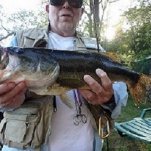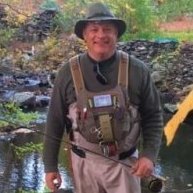-
Content Count
2,280 -
Joined
-
Last visited
Community Reputation
0 NeutralAbout Philly
-
Rank
Advanced Member
Previous Fields
-
Favorite Species
Smallmouth Bass
-
Security
22
Contact Methods
-
Website URL
http://
-
ICQ
0
Profile Information
-
Location
Philadelphia, PA SE PA
Recent Profile Visitors
14,760 profile views
-
Craft foam, either 3 mm or 6 mm foam. I tie most of my warm water flies with it. The simplest one is and my go to popper is a foam circle punched out of a foam sheet.
-
Nice. I usually look for old poppers at flea markets, seldom do I find them in "like new" condition. Often they need a new paint job, besides the legs, tails and eyes. Looks like you already replaced the legs. I was going to suggest rather than round rubber legs, replace them with silicone legs. More durable than the rubber legs.
-
When I took a couple of fly tying years ago they showed us how to do upright and split wings. I never mastered the method, so all my dry flies just have wrapped hackle for "wings". The trout don't seem to care. I've never been able to do a whip finish either with a tool or my fingers. The solution I came up with for small flies is to coat the thread with a bit of super glue and make a couple of wraps, then trim the tag end with a razor blade. For larger flies and warm water flies, which is pretty much all I tie these days, I place a floss threader on the head and make three or four wraps over it then pull the tag end under the wraps and trim with a razor blade. Somewhere I have a container full of flies I haven't been happy with but they cover the spectrum of flies I've tied over the years. Sometimes I go through them and strip the fly if it's tied on a style of hook I'm short of. The only thing I'm finicky about these days is making sure the legs that go through the body on some of my poppers are level when I pull them through the body.
-
I've been going up to a lodge in NE Ontario for close to 40 years. When I started bringing my fly rods with me I made leaders using the knotable wire. I didn't like the way the flies turned over with the wire, so I switched over to using a straight 5 to 7 foot piece of 25# fluorocarbon, though I do carry spools of 30# and 40# fluorocarbon and started tying my pike flies/streamers on long shank hooks. Now the lake I go to is noted for it walleye and smallmouth, not so much the pike. The pike we catch average between 20 and 28 inches. There are bigger pike in there, but I just haven't run into them. I've had bite offs because the pike totally inhaled the fly or the leader got wrapped and was sliced by the gill plate.
-
My sister has a place near Waitsfield, Vt. I flew up on Friday to join the rest of the family to watch the eclipse. We just set up chairs around the fire pit in the back yard with a table for snacks and drinks. It was worth flying up to see it and be with family. The drive back to Philly was not fun. It took us 11 hours. Normal drive is 7 hours.
-
I mostly fish still water lakes. The ones I fish are pretty weedy, lots of lily pads. The only place I've fished for trout in lakes is Vermont. I mainly used CDC and Elk, targeting rising fish. Subsurface for bass, leech patterns, buggers, bait fish patterns, dragonfly and damsel fly nymphs, crayfish patterns. Top water, poppers, sliders and booby flies. might want to consider frog patterns. As already mentioned look for structure, brush, downed trees. Don't ignore the shore line. Cast your fly toward the shore and retrieve. Docks and boat ramps are other targets.
-
Thanks for the tip, I will definitely look into that. Just a follow-up on what Fruitrollup said. I use the silicone legs for my foam flies. The silicone legs, what they call "sili legs" in fly fishing catalogs and stores, are silicone skirt layers. What they use for spinner baits and swim jigs. If planning to use a lot of them, they're cheaper than the packs of "sili legs" with a better selection of colors. You should be able to find them in most tackle stores, Bass Pro/Cabela's, Wal-Mart or online. Or if you have any spinner baits or swim jigs lying around that you don't plan to use anymore you can cannibalize them.
-
I tie a lot of foam flies. I have a couple of CA's in my warm water box. A good job. Not much to critique. One, usually the "tail" is pointing up. It looks like your thread is fraying. Any idea why? Sometimes, but it would only be for the rear wrap, the thread hits the hook point and frays. Tie the legs in last. That way if you want to trim the foam body, the legs won't get in the way.
-
Overall, it looks good. It will certainly catch fish. A couple comments. The tail looks good. A good rule of thumb is the tail should be as long as the hook shank. The head needs work. When you're wrapping just make sure the threads are up against each other. One of the disadvantages of using a down-eyed hook is if you make the head to big, you can block the hook eye. When you're cutting/trimming the tag end hold it tight and use a sharp pair of scissors or a single edge razor blade to cut it. That should prevent the fraying around the hook eye. It looks like you wrapped the tail down the bend of the hook. Just stop your wrap at the end of the hook shank. To me the hackle seems a bit long, but my personal preference is for the hackle to be long enough to be just below the hook point. I tend to use wide gape hooks. Again good work.
-
I've tied a couple size 20 buggers. They were tied on size 20, I think, 3xl or 4xl. It's been a while since I tied them. I used the smallest bead I had. I had to use dry fly hackle for them. I'll see if I can take a picture of them and post it. Surprisingly, I caught a few trout on them.
-
My preference is a straight eye hook rather than a down-eye hook. When I started tying, I brought the specific hook for the pattern, but I realized I just needed a straight shank hook and a curved shank hook. So I settled on the TMC 101 and the TMC 2488 for my trout flies. Warm water I found I could use various non-fly fishing hooks for my patterns. They were often cheaper than the "fly tying" hooks.
-
Overall, it looks good. You could still coat the body with UV resin. You would just have to be careful in the back. One thing I do is color the body and coat it with UV resin before I glue the body on the hook. Eliminates the possibility of getting the UV resin on the tail materials. A couple of things to think about. Rather than tying the first batch of the silicone legs on the hook shank consider pulling them through the body. It will reduce the clutter on the back of the shank and distribute the weight better. Color the body, including the eye "sockets" before you put the eyes in. My personal preference is not to use feathers for the tail, but as far as I can tell you have them tied in correctly, shiny side out. Excellent job on the coloring, considering you're using the double barrel popper body. It's tough to blend the colors with that particular body. Excellent job. You should catch a lot of bass with that fly.
-
I use to make my own leaders, nothing fancy. Once I discovered furled leaders, I quit making them. I don't make my own furled leaders but over the years I've acquired several by swapping flies and/or materials for them. I don't think I ever used more than two flies. Nothing fancy there. Just a dropper from 12 to 18 inches tied off the bend of the hook. I've caught two panfish on that rig several times and one time a couple of small bass. A bit more excitement than I like.
-
A vest usually, the same Orvis vest that DFoster posted. I don't know how old mine is. Maybe 15 years. If I'm trout fishing I only have a couple of boxes that get stuffed in the vest pockets. Since the creek I fish is stocked and is a warm water creek. I have an old camera bag that I put the warm water boxes in. If I'm fishing from shore or a boat, I have a bag that holds 8 or so boxes of my warm water flies. Throw in a wading stick and a net attached to various parts of my vest.
-
We were suppose to have a hatch 3 years ago. The creek I fish is an urban one and there wasn't much, if any, 17 year hatch along it, even though there's a good hatch of the annual cicadas. The annuals are about the same size as the 17 year ones but green in color. In the hype before the hatch I tied up some foam bugs to imitate the 17 year one. I did fish them during the annual hatch and caught a couple of bass on them. The color didn't seem to matter. They're a pretty big bug, close to two inches long





.thumb.JPG.34e862dceb3dd8be4646d978796518d1.JPG)